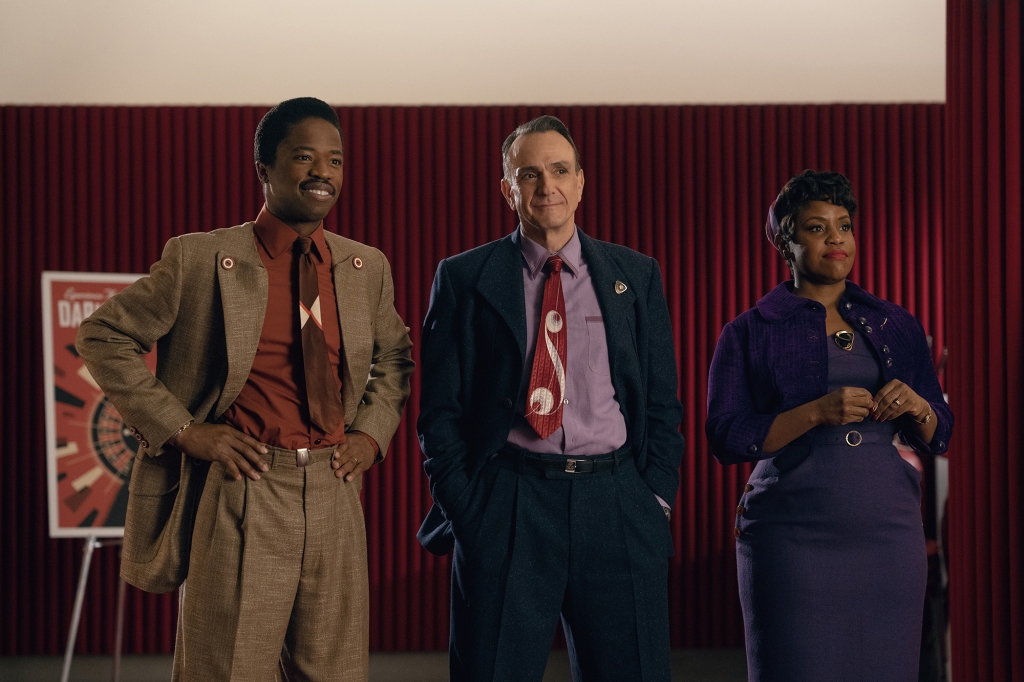The weird steampunk world of Apple TV+ series ‘Hello, Tomorrow!’
Welcome to “Hello, Tomorrow,” where everything isn’t as it seems.
The new Apple TV+ series, starring Billy Crudup as a fast-talking salesman with secrets, unfolds in a weird, hybrid world mixing 1950s attitudes, clothing and lifestyles with a quasi-steampunk futuristic flavor. It’s a world in which sandwiches cost 40 cents, people tool around in tail-finned, flying cars; robots do everything from walking the dog to delivering mail to crooning at swank soriees; and there are black-and-white video telephone calls and holograms programmed with punch cards. That places “Hello, Tomorrow!” in its own quirky universe of time and space: it could be a futuristic version of Eisenhower-era America or in the future from now. Who knows? It’s simultaneously compelling and sometimes distracting — but never boring.
Crudup plays smarmy Jack Billings, the star shill for the Brightside Lunar Residence, a moon-based colony of houses and timeshares (“Zero money down, $150 a month, no taxes!”) who stops at nothing, including skirting the truth, to close a deal. Jack’s life changes when he and his sales crew — Shirley (Haneefah Wood), Herb (Dewshane Williams) and gambling addict Eddy (Hank Azaria) — are dispatched by the lunar-based home office to drum up sales in the nearby town of Vistaville. Jack, who’s long-divorced, has family there, including his ex-wife and a son he hasn’t seen in 20 years and doesn’t know and his crotchety mother (Jacki Weaver), who’s never forgiven him for robbing her of her grandson. Meanwhile, his ex-wife, Marie, is subsequently knocked into a coma by an errant, self-driving package truck “delivering smiles” to her house.

Enter Joey Shorter (Nicholas Podany), a bright young man and devoted son who’s working a dead-end job in a grocery story and worrying about his hospitalized mother. He’s inspired by Jack’s homespun Brightside sales pitch; Jack, through a series of events, realizes that Joey is actually the son he hasn’t seen in years — and who doesn’t know Jack’s true identity. He hires Joey to be his new salesman in a bilateral gesture of guilt and parental pride; turns out his kid’s a chip off the old salesman block. But trouble finds the Brightside crew when Myrtle (Alison Pill), enraged at being ripped off in a “didn’t read the fine print” situation regarding her duplex on the moon, starts crusading to take the company down — and that’s when “Hello, World!” takes a series of turns that unravel over the course of its 10 episodes.
While Crudup, Wood et al. are the titular stars of the series, that distinction also applies to the show’s production designer (Maya Siegel) and art director (Katie Citti) and the way in which they’ve combined to create a clever world that starts with a memorable opening-credits sequence establishing the show’s tone/attitude while they continue to drop surprises in nearly every scene vis-a-vis space-age-ish gadgets and gizmos that are part Buck Rodgers/Dick Tracy and part 21st Century (and beyond), all with careful attention to detail — down to the slightly blurry images on the screens of the video phone calls that are reminiscent of a live, ’50s-era television show or kinescope.
Crudup delivers a smooth performance that’s in line with the show’s funky attitude (he also resembles “Twilight Zone” creator Rod Serling, which helps in the fantastical end of things). Podany, Pill, Wood, Pill, Azaria and Williams all shine in their respective roles, and there are nice turns from Matthew Maher as Costopoulos, a martinet-like, awkward local government official devoted to his rules and bureaucratic paperwork, and Frankie Faison as Buck Manzell, a retired TV star (“Space Sheriff”) who unwittingly helps Jack sell his scheme to a gullible public.
Read the full article Here


